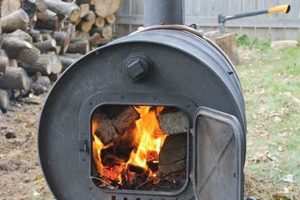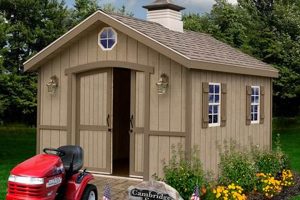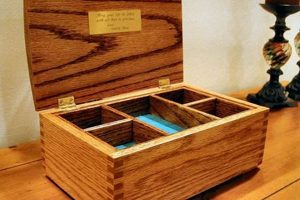A self-constructed container, typically fashioned from timber, designed for the storage and organization of implements used in various trades and crafts. Such a project allows for customization in size, compartments, and overall design to accommodate specific tool collections and user preferences. For example, a carpenter might build one with specialized slots for chisels and saws, while a mechanic’s version may feature deeper drawers for wrenches and sockets.
The construction of such a storage unit offers several advantages, including cost savings compared to commercially manufactured alternatives, the opportunity to tailor the design to individual needs, and the satisfaction derived from a hands-on building experience. Historically, these handcrafted chests represented a core element of a tradesperson’s inventory, often passed down through generations and imbued with practical and sentimental value. They reflect an ethos of self-reliance and resourcefulness.
The following discussion will explore key considerations in planning and executing a timber-based implement storage project, including material selection, construction techniques, design principles, and finishing options. Subsequent sections will delve into specific project examples and provide practical guidance for builders of all skill levels.
Construction Strategies for Timber-Based Implement Storage
This section outlines essential considerations for successfully completing a self-constructed timber implement storage project. Emphasis is placed on precision, durability, and functional design.
Tip 1: Material Selection: Opt for hardwoods such as oak, maple, or birch for enhanced durability and longevity. Softwoods like pine are acceptable for less demanding applications, but require careful sealing and finishing to prevent dents and scratches. Ensure timber is kiln-dried to minimize warping and cracking.
Tip 2: Precise Measurements and Cutting: Accurate measurements are paramount. Employ a high-quality measuring tape and a sharp saw. Use a combination square to ensure right angles and consistent dimensions. Inaccurate cuts compromise structural integrity and aesthetic appeal.
Tip 3: Joinery Techniques: Choose appropriate joinery methods based on skill level and desired strength. Dovetail joints offer superior strength but demand advanced woodworking skills. Simpler butt joints reinforced with screws and glue are suitable for less critical areas.
Tip 4: Hardware Selection: Invest in quality hinges, latches, and drawer slides. Cheap hardware often fails prematurely, requiring costly repairs or replacements. Stainless steel or brass hardware offers superior corrosion resistance.
Tip 5: Layout and Organization: Plan the interior layout meticulously. Consider the size and shape of the tools to be stored. Utilize dividers, trays, and specialized holders to maximize space efficiency and prevent tool damage. Prioritize accessibility of frequently used implements.
Tip 6: Finishing Techniques: Apply a durable finish to protect the wood from moisture, scratches, and stains. Polyurethane varnish provides excellent protection and is relatively easy to apply. Consider multiple coats for increased durability. Proper sanding between coats is essential for a smooth, professional finish.
Tip 7: Reinforcement: Reinforce corners and stress points with metal brackets or wooden cleats to enhance structural integrity, particularly if the storage unit will be subjected to heavy loads or frequent transport.
These strategic approaches, when implemented thoughtfully, contribute significantly to the creation of a durable, functional, and aesthetically pleasing self-constructed timber implement storage solution. Adherence to these guidelines ensures a worthwhile and long-lasting investment.
The subsequent section will address common challenges encountered during the building process and offer troubleshooting strategies to mitigate potential issues.
1. Planning
The initial stage of constructing timber implement storage, commonly termed “planning,” dictates the project’s trajectory and ultimate success. Inadequate preliminary consideration often results in structural deficiencies, inefficient space utilization, and an overall diminished value proposition. A comprehensive planning phase involves assessing the existing tool inventory, determining optimal dimensions for the chest, and creating a detailed blueprint. This stage necessitates evaluating workspace constraints, selecting appropriate materials, and devising a feasible construction timeline. For example, omitting the planning stage may lead to a chest that is too small to accommodate all tools, or one that is too large and unwieldy for the available workspace. The absence of a detailed blueprint can result in misaligned joinery and compromised structural integrity.
Detailed planning further incorporates considerations for internal organization and accessibility. Compartmentalization strategies, drawer configurations, and the inclusion of specialized tool holders are critical elements to address. For instance, a mechanic might prioritize deep drawers for socket sets and wrenches, while a carpenter might focus on racks for chisels and saws. Neglecting these organizational aspects can lead to a cluttered and inefficient storage solution, increasing retrieval times and potentially damaging delicate instruments. Furthermore, the planning phase must encompass a budget assessment, considering material costs, hardware expenses, and the potential need for specialized tools. This financial projection aids in preventing cost overruns and ensuring the project remains economically viable.
Effective planning establishes a solid foundation for a successful timber implement storage project. By meticulously analyzing requirements, developing a comprehensive blueprint, and carefully considering material and financial constraints, the potential for errors is minimized, and the likelihood of a durable, functional, and aesthetically pleasing outcome is significantly increased. The planning phase serves as a crucial investment, ensuring that the subsequent construction efforts are efficient, purposeful, and ultimately, rewarding.
2. Joinery
Joinery, encompassing techniques for connecting wood pieces, is fundamental to the structural integrity and aesthetic quality of any self-constructed timber implement storage project. The choice and execution of joinery methods directly influence the strength, durability, and visual appeal of the final product.
- Dovetail Joints
Dovetail joints, recognized for their interlocking tails and pins, provide exceptional tensile strength and resistance to racking forces. Commonly used in drawer construction and box corners, dovetails enhance the longevity of high-stress areas within a timber implement storage unit. The precise execution of dovetails requires skill and careful attention to detail.
- Mortise and Tenon Joints
Mortise and tenon joints involve inserting a projecting tenon into a corresponding mortise (hole) to create a strong and stable connection. Employed for frame construction, leg attachments, and creating robust structures, mortise and tenon joints offer significant strength and resistance to shear forces. They are particularly relevant in chests designed for heavy tool storage.
- Rabbet and Dado Joints
Rabbet joints, formed by cutting a recess along the edge of a board, and dado joints, cut across the width of a board, are simpler joinery methods offering adequate strength for less demanding applications. Often used for drawer bottoms, back panels, and shelf supports within the implement storage unit, rabbet and dado joints facilitate efficient construction and enhance structural stability.
- Butt Joints
Butt joints, formed by simply butting two pieces of wood together, represent the simplest form of joinery. While structurally weak on their own, butt joints can be reinforced with screws, nails, or glue to provide sufficient strength for non-critical areas of the implement storage unit. They are commonly used for attaching trim pieces or constructing simple box frames.
The selection of appropriate joinery techniques is crucial for ensuring the structural integrity and longevity of a self-constructed timber implement storage solution. Skillful execution, regardless of the chosen method, translates to a durable and reliable unit capable of withstanding the rigors of tool storage and use.
3. Materials
The selection of materials is a paramount determinant of the longevity, functionality, and overall aesthetic of a self-constructed timber implement storage unit. Material choice directly affects the structural integrity, resistance to environmental factors, and the unit’s capacity to withstand the weight and wear associated with tool storage. Hardwoods, such as oak, maple, and cherry, provide superior strength and durability, resulting in a robust chest capable of enduring frequent use and heavy loads. These materials are naturally more resistant to dents, scratches, and moisture absorption compared to softwoods. Conversely, softwoods, including pine, fir, and cedar, offer cost-effectiveness and ease of workability but necessitate protective finishes to mitigate their inherent susceptibility to damage.
The specific application dictates the optimal material selection. For example, a chest intended for stationary use within a controlled environment may be constructed from pine, provided a suitable protective coating is applied. However, a chest designed for transport or exposure to varying environmental conditions demands the inherent strength and moisture resistance of a hardwood. Furthermore, the selection of fasteners, adhesives, and finishing products must complement the primary material. Corrosion-resistant screws and high-quality wood glue contribute to the structural integrity, while a durable varnish or sealant protects against moisture, UV radiation, and physical abrasion. The integration of unsuitable ancillary materials can compromise the overall performance and lifespan of the storage unit.
In summary, material selection constitutes a critical decision point in the construction of a self-constructed timber implement storage solution. The careful consideration of wood type, fastener compatibility, and finishing product properties directly correlates with the unit’s durability, functionality, and aesthetic appeal. Neglecting material considerations risks compromising the structural integrity and longevity of the project, resulting in a premature failure and diminished value proposition. A comprehensive understanding of material properties and their interaction with the intended application is essential for achieving a successful and enduring outcome.
4. Dimensions
Dimensional accuracy is paramount in self-constructed timber implement storage. The specific measurements directly dictate the capacity, organization, and usability of the chest. Incorrect dimensions can lead to insufficient space for essential tools, rendering the chest functionally inadequate. For example, failing to account for the length of a frequently used handsaw will necessitate either storing the saw outside the chest or undertaking inconvenient modifications post-construction.
Precise dimensional planning extends beyond overall size to encompass internal compartment design. Drawer depths must accommodate tool heights, while dividers require accurate sizing to prevent tools from shifting during transport. Consider a mechanic’s tool chest: Shallow drawers may not suffice for socket sets, while excessively deep drawers hinder efficient organization. Furthermore, external dimensions impact portability and storage space within the workshop. A chest too large may prove unwieldy, while a chest too small compromises tool accessibility and storage volume. Standard sheet lumber sizes should also influence dimensional decisions to minimize material waste.
In conclusion, dimensional precision forms a foundational element of a successful timber implement storage project. Its importance stems from the direct influence on capacity, organization, portability, and efficient material use. Attentive planning of dimensions is critical, minimizing frustration and ensuring the final product effectively fulfills its intended purpose, aligning storage capacity with workshop layout and tool inventory.
5. Hardware
The selection and application of hardware constitute a critical aspect of timber implement storage construction. Hardware components, encompassing hinges, latches, drawer slides, handles, and fasteners, directly influence the functionality, durability, and security of the finished chest. Substandard hardware can lead to operational failures, compromised structural integrity, and a shortened lifespan for the entire unit. For example, hinges of inadequate strength may fail under the weight of a fully loaded lid, while flimsy latches offer minimal protection against theft or accidental opening. The choice of fasteners, such as screws or nails, must align with the timber type and joinery techniques employed. Improper fastener selection can weaken joints and compromise the overall structural stability.
Consider a chest designed for transporting valuable tools to job sites. In this context, heavy-duty latches, robust handles, and reinforced corners are essential. Locking mechanisms provide added security, deterring unauthorized access. Smooth-gliding drawer slides enhance usability and prevent drawers from sticking or binding, particularly when loaded with heavy implements. The material composition of the hardware is also a significant factor. Stainless steel or brass hardware offers superior resistance to corrosion, making it ideal for chests exposed to moisture or outdoor conditions. In contrast, plated steel hardware, while more economical, is susceptible to rust and may require frequent replacement.
In summary, the connection between hardware and timber implement storage construction is inextricable. Hardware components are not merely cosmetic additions; they are integral elements that significantly impact the functionality, security, and longevity of the storage unit. Prudent hardware selection, coupled with proper installation techniques, ensures a durable and reliable storage solution capable of withstanding the rigors of tool management and transportation.
6. Finish
The application of a finish to a self-constructed timber implement storage unit serves several critical functions, directly impacting its longevity, aesthetic appeal, and protective capabilities. A finish acts as a barrier against environmental factors, such as moisture, ultraviolet radiation, and physical abrasion, which can degrade the timber over time. Without a suitable finish, the wood is susceptible to warping, cracking, staining, and fungal growth, ultimately compromising the structural integrity of the chest. Therefore, the selection and proper application of a finish are not merely cosmetic considerations but essential steps in preserving the investment of time and resources dedicated to constructing the unit.
The choice of finish depends on several factors, including the type of wood used, the intended environment of the chest, and the desired aesthetic outcome. For example, a chest constructed from oak and intended for use in a humid environment would benefit from a moisture-resistant finish such as polyurethane varnish. This type of finish forms a durable, protective layer that prevents moisture from penetrating the wood, thus mitigating the risk of warping or fungal growth. Conversely, a chest constructed from pine and used primarily indoors might benefit from a stain and lacquer finish, enhancing the wood’s natural grain while providing adequate protection against scratches and minor spills. The application process itself is critical; proper surface preparation, including sanding and cleaning, ensures optimal adhesion of the finish and a uniform, visually appealing result. Multiple coats are often necessary to achieve the desired level of protection and durability.
In summation, the application of a finish to a self-constructed timber implement storage unit is an indispensable process, impacting its durability, aesthetic quality, and resistance to environmental damage. Careful selection of the appropriate finish, coupled with meticulous application techniques, ensures the long-term preservation of the chest, safeguarding its functionality and enhancing its overall value. Neglecting the finishing process leaves the wood vulnerable to degradation, ultimately diminishing the lifespan and utility of the storage unit.
Frequently Asked Questions Regarding DIY Wooden Tool Chest Construction
This section addresses common inquiries concerning the design, construction, and maintenance of self-constructed timber-based implement storage units. The intent is to provide clarity on critical aspects, enabling informed decision-making during the building process.
Question 1: What timber species are best suited for constructing a robust and durable implement storage unit?
Hardwoods, such as oak, maple, and birch, exhibit superior strength and resistance to wear, rendering them ideal for applications demanding long-term durability. Softwoods, like pine, can be employed but necessitate careful sealing and protection against dents and moisture.
Question 2: What joinery techniques provide the most structural integrity for connecting wooden components?
Dovetail joints offer exceptional strength, particularly in drawer construction. Mortise and tenon joints are well-suited for frame construction and leg attachments. Rabbet and dado joints provide adequate strength for less critical areas, such as drawer bottoms and shelf supports.
Question 3: What type of finish offers optimal protection against moisture and abrasion?
Polyurethane varnish provides a durable, water-resistant barrier, safeguarding the wood against moisture, scratches, and stains. Multiple coats, applied with proper sanding between each layer, enhance the protective properties and aesthetic appeal.
Question 4: How can internal organization be maximized within a limited space?
Utilize dividers, trays, and custom-designed holders tailored to the dimensions of specific tools. Prioritize accessibility for frequently used implements and consider tiered storage solutions to maximize vertical space.
Question 5: What hardware considerations are essential for ensuring long-term functionality?
Invest in high-quality hinges, latches, and drawer slides constructed from corrosion-resistant materials such as stainless steel or brass. Ensure that fasteners are appropriately sized and compatible with the timber species employed.
Question 6: How can potential warping or cracking of the wood be minimized?
Utilize kiln-dried timber to reduce moisture content. Apply a sealant or finish to all surfaces, including interior components, to create a barrier against moisture absorption. Avoid exposing the finished chest to extreme temperature fluctuations or direct sunlight.
The construction of a durable, functional, and aesthetically pleasing timber implement storage unit necessitates careful attention to material selection, joinery techniques, finishing processes, and hardware components. Thorough planning and meticulous execution are critical for achieving a successful outcome.
The subsequent section will explore case studies of successful timber implement storage unit construction projects, highlighting innovative design solutions and effective problem-solving strategies.
Conclusion
The preceding discussion explored multifaceted aspects of the diy wooden tool chest, encompassing design, material selection, construction methodologies, hardware implementation, and finishing techniques. Emphasis was placed on the critical interrelationship between these elements and their collective influence on the storage unit’s durability, functionality, and aesthetic qualities. Considerations regarding planning, dimensional accuracy, joinery execution, and environmental protection were presented as essential components of a successful construction endeavor.
The creation of a durable and functional implement storage solution demands careful planning, meticulous execution, and a comprehensive understanding of woodworking principles. The self-constructed diy wooden tool chest represents not only a practical storage solution but also an exercise in craftsmanship and resourcefulness. Continued exploration of advanced joinery techniques, innovative organizational strategies, and sustainable material sourcing promises to further enhance the utility and longevity of these handcrafted storage solutions.







